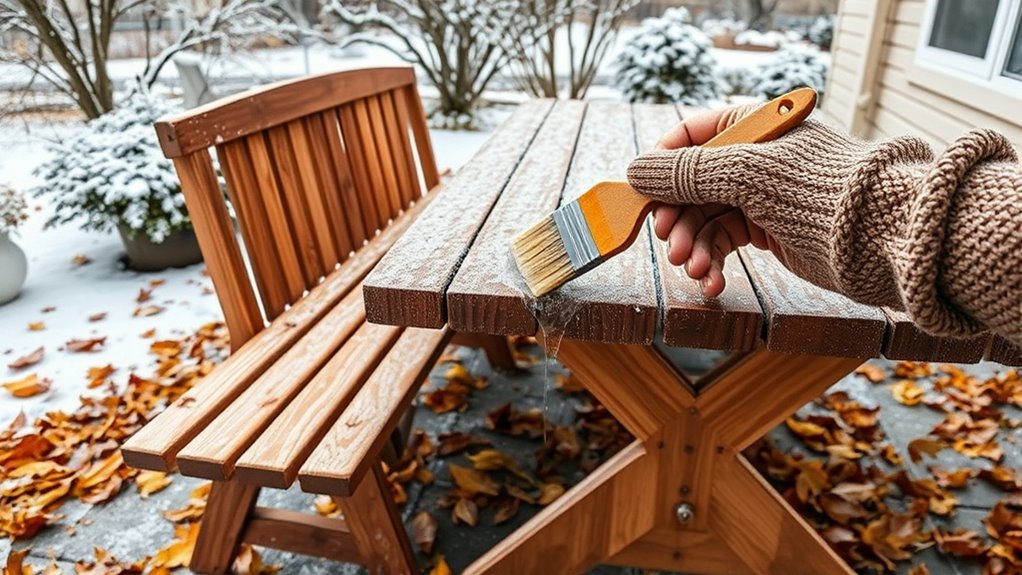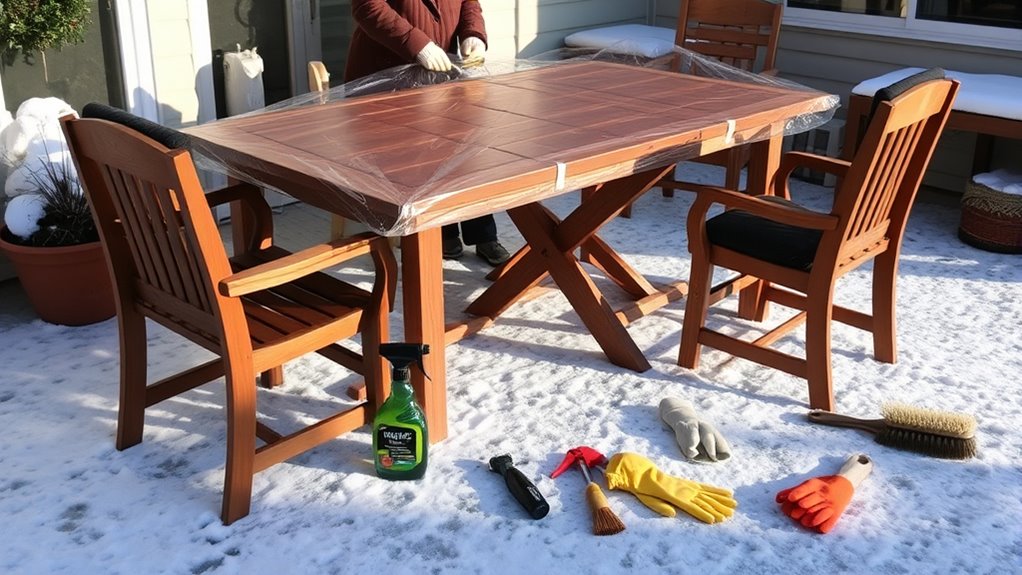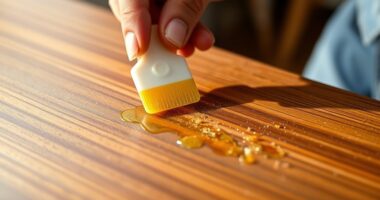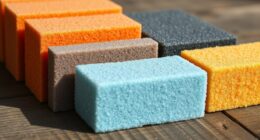To winterize your outdoor wood furniture in three simple steps, start by cleaning it thoroughly with gentle soap and water to remove dirt and grime. Next, inspect for any damage or loose joints, repairing as needed to guarantee stability. Finally, apply a high-quality waterproof sealant to protect against moisture, and cover or store the furniture indoors. To learn more about keeping your furniture in top shape year-round, discover the details below.
Key Takeaways
- Clean furniture thoroughly with gentle soap and water, then dry completely to remove dirt and moisture.
- Inspect for damage, repair loose joints or splinters, and ensure structural integrity.
- Apply a high-quality, water-resistant sealant to create a protective moisture barrier.
- Cover furniture with waterproof, breathable covers or store indoors to shield from snow and rain.
- Regularly check covers and remove snow promptly to prevent weight and moisture damage.

As winter approaches, safeguarding your outdoor wood furniture from the harsh elements is essential. The cold, moisture, and fluctuating temperatures can take a toll on your furniture’s appearance and structural integrity. To keep your investment looking its best year after year, you need to focus on seasonal maintenance that prioritizes furniture preservation. Proper preparation now will pay off by reducing wear, preventing damage, and extending the lifespan of your outdoor pieces.
Protect your outdoor wood furniture this winter to preserve its beauty and durability year-round.
The first step in winterizing your outdoor wood furniture is cleaning it thoroughly. Dirt, pollen, and grime can trap moisture against the wood, accelerating rot and decay. Use a gentle soap or specialized wood cleaner combined with a soft-bristled brush or sponge. Rinse with water and allow the furniture to dry completely. This step is essential because any residual moisture can freeze and cause cracks or warping during colder months. Once dry, inspect the furniture for any loose joints, splinters, or damage. Address these issues now with wood glue or small repairs to make sure your furniture remains sturdy and intact through winter.
Next, applying a high-quality sealant or protective finish is indispensable for furniture preservation. Choose a water-resistant sealant designed specifically for outdoor wood. This creates a barrier against moisture, preventing water from seeping into the pores of the wood and causing swelling or rot. Be sure to follow the manufacturer’s instructions for application and drying times. Reapply the sealant annually or as needed, especially after cleaning. This extra layer of protection will keep your furniture looking vibrant and prevent the deterioration that harsh winter conditions can bring. Additionally, understanding how contrast ratio influences the appearance of your outdoor furniture can help you select finishes that maintain color vibrancy and clarity over time.
Finally, once your furniture is clean and sealed, consider adding protective covers or storing it indoors if possible. Covering your outdoor furniture with waterproof, breathable covers shields it from snow, ice, and heavy rain. If space allows, storing your furniture in a shed, garage, or basement provides the best protection from the elements. If storage isn’t feasible, stacking or covering individual pieces minimizes exposure. During periods of heavy snow or rain, check covers regularly for damage or moisture buildup, and clear off snow to avoid unnecessary weight and moisture retention. This proactive approach ensures your furniture remains in excellent condition, ready for use when spring arrives.
Frequently Asked Questions
Can Outdoor Wood Furniture Be Stored Indoors During Winter?
Yes, you can store outdoor wood furniture indoors during winter for added winter protection. Moving it indoors keeps it safe from harsh weather, preventing damage from moisture and temperature fluctuations. Make sure to clean and dry your furniture thoroughly before indoor storage. Find a dry, well-ventilated space like a garage or basement. This way, your furniture stays in excellent condition, ready to enjoy when warmer weather returns.
What Type of Protective Finish Is Best for Winterizing Wood Furniture?
You might think any finish protects your outdoor furniture, but weatherproof coatings are actually your best bet. They create a durable barrier against moisture, UV rays, and temperature changes. Protective finishes like marine varnish, oil-based sealers, or polyurethane are specially formulated for outdoor use. Applying these guarantees your wood stays vibrant and intact through winter, preventing cracks, warping, and rot. Choose a high-quality weatherproof coating for lasting protection.
How Often Should I Reapply Sealant Each Winter Season?
You should reapply sealant each winter season based on your furniture’s exposure and the product’s durability. Generally, a winter reapplication every 1-2 years suffices, but if you notice peeling or cracking, it’s time for a fresh coat. Consistent sealant frequency helps maintain protection against moisture and weather damage. Regularly inspecting your wood furniture ensures you know when to reapply sealant for peak winter preservation.
Is It Necessary to Cover Furniture if Stored in a Shed?
Like a knight protecting their scrolls, you should consider covering your furniture even if stored in a shed. While shed storage offers protection from the elements, covering options like weatherproof covers prevent dust and pests from settling in. This extra step guarantees your outdoor wood furniture stays in top shape, ready for spring. Covering is a simple, effective way to extend its life beyond just relying on the shed alone.
What Are Signs My Furniture Needs Repair After Winter?
After winter, check your furniture for signs of wood rot or structural damage. Look for soft spots, discoloration, or crumbling wood, which indicate rot. If the furniture feels wobbly or parts are loose, it needs repair. Address any wood rot early to prevent further damage, and reinforce or replace weak areas. Regular inspections help keep your outdoor wood furniture sturdy and safe for next season.
Conclusion
By winterizing your outdoor wood furniture, you’re practically giving it a superhero’s shield against the harshest winter storms. Imagine your furniture standing tall and proud, unscathed by freezing temperatures, snow, and ice—like a fortress of durability. With just three simple steps, you’re turning your outdoor space into a fortress of beauty and resilience. Don’t wait for winter’s chaos to strike—protect your furniture now and keep your outdoor oasis looking flawless all season long!









